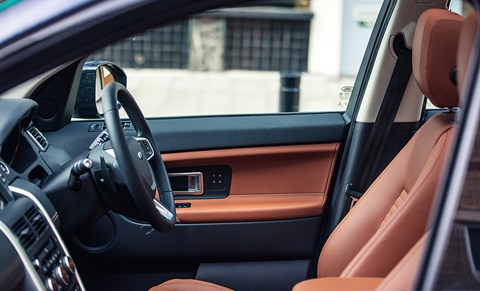► Welcome to our new Land Rover Disco Sport
► We opt for the 1999cc diesel, nine-speed auto
► Shame about the Stone Age infotainment screen
Things that get taken for granted: water, wi-fi connectivity, wives, democracy, the family car. Indeed, you know you’ve got the ideal car when it slips into the background of your life, effortlessly carting the family and their myriad possessions, performing reliably, devoid of niggles and not supping too much fuel, while still being thoroughly satisfying to drive. Can Land Rover’s Discovery Sport fulfil that brief over the next 12 months?
Despite resembling a shrunken Range Rover Sport, the Discovery Sport doesn’t ooze status and performance but deeply unpretentious practicality. This is a seven-seat SUV, or 5+2 in Land Rover-speak, in a bid to make the rear seats as forbidding to grown-ups as a Donald Trump presidency.
The packaging is witchcraft: seven perches in an SUV barely a marker pen-longer than the deposed Freelander 2. Only the more elongated Hyundai Santa Fe and Nissan X-Trail offer the same versatility in the midsize SUV segment: otherwise you must trade up to the vast Q7 or XC90, or venture into MPV territory. But the latter forsake the Disco Sport’s raised ride height and dominant world view, and its related off-road capability.
The drivetrain choice is surprisingly uncomplicated for UK buyers. There’s just one 2.0-litre ‘Ingenium’ diesel engine, with either 148bhp/276lb ft or 178bhp/317lb ft. Unlike in the Evoque, there’s currently no front-wheel-drive option: choose from six-speed manual or nine-speed automatic transmission to channel power to all four wheels. We’ve opted for the higher output engine (naturally) and stumped up £1805 for the auto: its different ratios bite a whole second from the manual’s 9.4sec 0-62mph time.
The Discovery Sport came to market with a 2.2-litre Ford diesel, but the JLR-developed and built Ingenium unit replaced it last summer. It’s smooth, even when you wind it out to the redline, and combustion clatter is well suppressed. The same four-pot powers our long-term Jaguar XE too, where it makes a bellowing noise twinned with Pavarotti’s vacuum cleaner, accompanied by an induction whistle reminiscent of a badly tuned radio. Surely some mistake: an SUV engine sounding more refined than a Jag’s!
Carbon emissions are 139g/km, with a combined fuel consumption figure of 53.3mpg (both figures lag way behind the Jaguar’s, as you’d expect given the Land Rover is 319kg heavier). But in our first full month at the wheel, mostly during fast motorway commutes, the Disco averaged 33.3mpg – that’s a shocking 37% off the official figure. Seriously need that economy to improve over time.
The entry-level 150PS manual SE costs £31,095, and the essentials are standard: climate control, DAB, Bluetooth, 18in rims, heated part-leather front seats, rear parking sensors. We graduated through two more trim levels: SE Tech which adds nav, front parking sensors and automates wipers, headlamps and tailgate (add £1500), and HSE (invest another £3700) whose highlights include powered leather seats, glass roof panel, keyless entry and Xenons with auto high beam.
Our trim level is £43,400 HSE Luxury, or National Trust spec as christened by features ed Ben Miller. You can create a more expensive Discovery Sport with black gloss grille and mirror caps (HSE Black), or the same gothic details combined with a sports bodykit (HSE Dynamic Lux) but both seem a little showy and go against our Land Rover ideal. We selected muted blue metallic (£625) and eschewed the Evoque-style contrasting roof for £520.
HSE Lux wraps the powered/heated/cooled seats in cow (in a suitable rich fudge colour), and adds posterior warming and USB ports for the second row too. Trump seat occupants also get a USB socket to fight over and dedicated climate control too. The final features are illuminated treadplates and configurable mood lighting, plus automated parking modes which can be deployed if hands need a break from the heated steering wheel.
Given the luxurious equipment levels, the only option ticked was the £2590 entertainment pack, which includes upgraded, 17-speaker Meridian Audio system, TV tuner and hard disk navigation. Total price? £46,615.
First impressions? The primary ride is silky and loping, but when the surface gets choppy, occupants certainly feel it. The body is nicely controlled, with measured roll in corners. And the steering, though about as chatty as Kimi Räikkönen, is consistent, composed and encourages you to make the most of the plentiful front-end grip. Dynamically, I’m already taking the Disco for granted; time will tell if that applies to the rest of the package too.

Disco spec highlights
National trust spec: £625 Loire blue metallic for understated exterior; leather inspired by Werther’s Originals very appropriate
Wishbone wheels: Upgrading to handsome, irregularly spaced 20s free on HSE Lux
Stone age screen: Disco is last JLR car hobbled by slow, graphically challenged touchscreen
The cost of no cost: 17-speaker Meridian audio is gratis on HSE Lux – so long as you spec £2590 entertainment pack!
Logbook: Discovery Sport HSE luxury auto
Engine: 1999cc turbodiesel 4-cyl, 178bhp @ 4000rpm, 317lb ft @ 1750rpm
Transmission: 9-speed auto, 4wd
Stats: 8.4sec 0-62mph, 117mph, 139g/km
Price: £43,400
As tested: £46,615
Miles this month: 2442
Total miles: 4762
Our mpg: 33.3
Official mpg: 53.3
Fuel this month: £386.66
Extra costs: £0